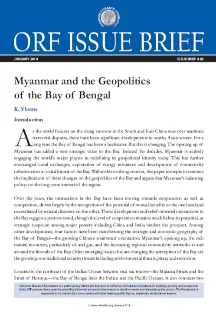As the world focuses on the rising tensions in the South and East China seas over maritime territorial disputes, there have been significant developments in nearby Asian waters. For a long time the Bay of Bengal has been a backwater. But this is changing. The opening up of Myanmar has added a new strategic value to the Bay. Isolated for decades, Myanmar is actively engaging the world’s major players in redefining its geopolitical identity today. This has further encouraged naval exchanges, exploration of energy resources and development of connectivity infrastructure in a vital littoral of the Bay. Within this evolving context, this paper attempts to examine the implications of these changes on the geopolitics of the Bay and argues that Myanmar’s balancing policy is in the long-term interest of the region.
Over the years, the interactions in the Bay have been moving towards cooperation as well as competition, driven largely by the recognition of the potential of mutual benefits on the one hand and necessitated by natural disasters on the other. These development and relief-oriented interactions in the Bay suggest a positive trend, though the level of cooperation remains much below its potential, as strategic suspicion among major powers including China and India hinders the prospect. Among other developments, four factors have been transforming the strategic and economic geography of the Bay of Bengal––the growing Chinese southward orientation; Myanmar’s opening up; the rich natural resources, particularly oil and gas; and the increasing regional connectivity networks in and around the littorals of the Bay. Other emerging issues that are changing the perception of the Bay are the growing non-traditional security threats including environmental threats, piracy and terrorism.
Located in the northeast of the Indian Ocean between vital sea routes––the Malacca Straits and the Strait of Hormuz––the Bay of Bengal links the Indian and the Pacific Oceans. It also connects two important regions––South Asia and Southeast Asia––with India, Bangladesh and Sri Lanka forming its western littorals while Myanmar, Thailand, Malaysia and Indonesia form its eastern littorals. Given this geostrategic location in the Indo-Pacific region, the Bay is strategically vital for the major powers. In the recent past, Myanmar has been increasing its interactions with regional as well as extra-regional powers in naval activities, energy exploration, regionalism and connectivity.
Within this evolving context, this paper attempts to examine the implications of these changes on the geopolitics of the Bay and argues that Myanmar’s balancing policy is in the long-term interest of the region.
The views expressed above belong to the author(s). ORF research and analyses now available on Telegram! Click here to access our curated content — blogs, longforms and interviews.

 PDF Download
PDF Download



 PREV
PREV


